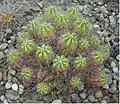| Echinocereus enneacanthus | |
|---|---|
.jpg.webp) | |
| Scientific classification | |
| Kingdom: | Plantae |
| Clade: | Tracheophytes |
| Clade: | Angiosperms |
| Clade: | Eudicots |
| Order: | Caryophyllales |
| Family: | Cactaceae |
| Subfamily: | Cactoideae |
| Genus: | Echinocereus |
| Species: | E. enneacanthus |
| Binomial name | |
| Echinocereus enneacanthus | |
| Synonyms | |
Echinocereus enneacanthus is a species of flowering plant first described by George Engelmann.[1][2]
Description
Echinocereus enneacanthus forms low cushions with 30 to 200 shoots. The cloudy to light green, cylindrical shoots, which are prostrate except for the tips, are up to 2 meters long and have a diameter of 3.5 to 15 centimeters. There are seven to ten ribs that are not clearly tuberculated. The one to four straight or curved, round to flattened, angular or furrowed central spines are yellowish to brownish or bluish. They are up to 8 centimeters long. The six to 13 straight, whitish to brownish marginal spines are up to 4 centimeters long.
The funnel-shaped flowers are magenta colored and have a darker throat. They appear below the shoot tips, are up to 8 centimeters long and reach a diameter of 8 to 12 centimeters. The spherical to egg-shaped fruits contain pink flesh and taste like strawberries.[3]
 Plant
Plant.jpg.webp) Plants growing in Villa Arista, San Luis Potosi
Plants growing in Villa Arista, San Luis Potosi.jpg.webp) Plants growing near Estacion Vanegas
Plants growing near Estacion Vanegas Flowers
Flowers
Subspecies
This species is divided into the following subspecies:[1]
- Echinocereus enneacanthus brevispinus
- Echinocereus enneacanthus enneacanthus
Distribution
Echinocereus enneacanthus is distributed in the United States in the states of New Mexico and Texas and in the north of the neighboring Mexican state of Sonora.
Taxonomy
The first description by George Engelmann was published in 1848. The specific epithet enneacanthus means 'nine-spined'.[4] Common names include “Alicoche,” “Banana Cactus,” “Cob Cactus,” “Green Strawberry Hedgehog,” “Pitaya,” “Prostrate Hedgehog Cactus,” “Purple Pitaya,” “Strawberry Cactus,” and “Strawberry Hedgehog Cactus.” A nomenclature synonym is Cereus enneacanthus (Engelm.) Engelm. (1849)[5]
References
- 1 2 "Species 2000 & ITIS Catalogue of Life: 2014 Annual Checklist". Species 2000: Reading, UK. 2014. Archived from the original on 3 July 2021. Retrieved 26 May 2014.
- ↑ "ITIS Standard Report Page: Echinocereus enneacanthus". www.itis.gov. Archived from the original on 2011-10-20. Retrieved 2021-06-30.
- ↑ Anderson, Edward F.; Eggli, Urs (2005). Das grosse Kakteen-Lexikon (in German). Stuttgart (Hohenheim): Ulmer. p. 196–197. ISBN 3-8001-4573-1.
- ↑ Wislizenus, F. A. (1848). Memoir of a tour to northern Mexico :connected with Col. Doniphan's expedition, in 1846 and 1847 /by A. Wislizenus. Washington: Tippin & Streeper. doi:10.5962/bhl.title.41509.
- ↑ Arts, American Academy of (1849). "Memoirs of the American Academy of Arts and Sciences". The Academy. ISSN 0096-6134. Retrieved 2023-10-28.
External links
 Media related to Echinocereus enneacanthus at Wikimedia Commons
Media related to Echinocereus enneacanthus at Wikimedia Commons Data related to Echinocereus enneacanthus at Wikispecies
Data related to Echinocereus enneacanthus at Wikispecies